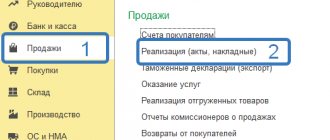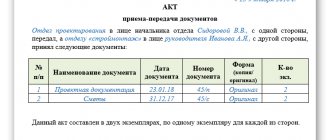in 1C: Accounting 3.0
Many users of “1C: Accounting 3.0” need to print using forms MX-1, MX-3 in the 1C program. Form MX-1 is required if an organization accepts inventory items for safekeeping.
We offer you print processing MX-1 and MX-3 for the “1C: Accounting 3.0”
Implemented for 1C:Fresh . You can find the MX-1, MX-3 stamp in the 1C:Fresh
. Read more…
Printing acts according to form MX-1 in 1C: Accounting 3.0
In 1C: Accounting, printing MX-1 may be required, in particular, in two cases:
- Inventory materials are accepted for safekeeping by your organization, on behalf of which you draw up documents in the 1C program
- The goods and materials remain for safekeeping with the supplier company that supplies you with the goods.
Therefore, printing of MX-1 acts in 1C is implemented for the document “Receipt of goods and services”.
Firstly, this is the most common situation of transfer for safekeeping. If you do not buy a product, but rather accept it for safekeeping, you can specially draw up the document “Receipt of goods and services” in 1C and print out the MX-1 act.
Secondly, the document “Receipt of goods and services” in 1C contains all the basic information necessary for automatically filling out the MX-1 act.
Necessary information for printing MX-1, MX-3 in “1C”:
- Organization accepting for safekeeping
- The counterparty who deposits for safekeeping
- List of inventory items indicating quantity and cost
How to correctly fill out the act of transfer for safekeeping in 2021?
As already mentioned, for these purposes it is recommended to fill out the MX-1 form. At first glance, it may seem that no difficulties can arise here. But the document still has certain nuances that should be remembered. To be able to complete this document yourself, you should consider filling it out step by step:
- at the top of the document information about the party who accepts the property is indicated. Here the legal and actual addresses, legal form are written down;
- The specific division is indicated below. This is where material assets will be stored. It would be useful to indicate the conditions and location of storage;
- the company that transfers the property is described in a similar way. The full name of the head of the company is indicated, and OKPO codes are also entered;
- since this act is an addition to the main document, it is necessary to indicate information about it. For example, this could be a contract. Its number and date of compilation are written down;
- The name of the document is written below and the date of its execution is indicated. In addition, the act must be assigned a number;
- The essence of the document should also be indicated here, namely, acceptance for storage. The period and exact storage location are noted.
Below is the main part, which is presented in table form. The corresponding columns indicate the name of the property, its characteristics, and quantity. If material assets are damaged or destroyed, the storage company will have to pay for the damage. That is why the table contains columns indicating the value of the property. Naturally, when signing a document, the receiving party must see the indicated price in order to understand the full responsibility of such actions. If several material assets are transferred for storage, then their quantity and total value are indicated under the table.
Under the table you can indicate the storage period and the conditions under which the property must be stored. Additional information is also written here if necessary. At the very bottom, information about the responsible persons is indicated. The position of the company representative and his signature with a transcript are noted. Similar information is indicated about the person who accepts the property for storage. If we talk about seals, we cannot call them mandatory. Although, if they are still used by organizations, stamps will not be superfluous.
Connecting the printing of acts MX-1, MX-3 in 1C: Accounting 3.0
The program for printing acts MX-1, MX-3 connects to 1C: Accounting 3.0 through the “Additional reports and processing” mechanism. Consequently, configuration modification is not required and you will not have any problems updating your 1C: Accounting configuration.
To connect processing, go to Administration - Printed forms, reports and processing - Additional reports and processing
.
Click Create
, the Security Warning window opens, then click Continue
Next, click Load from file and select the processing file and click Write and close
How to draw up an act of acceptance and transfer of material assets to an employee
The company develops the form independently. A similar one can be created for the case when an employee quits or returns from a business trip and hands over his work tools or equipment to the organization. The developed form will need to be consolidated in the company’s accounting policy.
What needs to be indicated in the document:
- Its name: act of acceptance and transfer of material assets to the employee.
- Place and date of compilation.
- Who transfers the values (name of the company or full name of the individual entrepreneur), full name and position of the person acting on behalf of the company, on the basis of which document it acts.
- To whom are the material assets transferred (full name and position of the employee, his passport details, place of residence).
- On the basis of what document did the employer transfer the valuables to the employee? This could be an employment contract (Article 21 and Article 22 of the Labor Code of the Russian Federation state that in order to perform duties the employee must receive everything necessary, this is stated in the employment contract), an additional agreement to it, an order.
- List of material assets with their characteristics: name (as in other documents), inventory number, quantity, cost. It is better to present this point in the form of a table. All digital data must be transcribed carefully.
- Material assets have been verified by the parties, there are no disagreements.
- Number of copies of the act. Usually there are 2 copies: for the employee and the employer.
At the end of the document there must be signatures of the parties. The document needs to be signed only when the parties have fully inspected the items.
Why do you need an acceptance certificate for the transfer of goods and materials?
Let's consider under what circumstances an acceptance certificate is drawn up:
- Discrepancy in numbers and inventory parameters.
- Arrival of goods and materials without documents.
- Transfer of inventory items for safekeeping.
- Transfer of assets by agreement of the commission.
- Transfer of inventory items within an institution between departments or financially responsible employees.
- Transfer of inventory items into temporary storage.
The example document below can be used together with the acceptance certificate for storage (form MX-1).
Receipt of products against an invoice implies the possibility that the goods delivered do not correspond to the quantity displayed on the invoice. However, there are circumstances when the actual quantity of products does not coincide with the declared quantity. To make a claim to the seller, it is necessary to reflect this circumstance in the acceptance certificate with recording of the identified discrepancies.
Acceptance of some types of goods and materials (for example, equipment) is carried out according to an act, since this is required by the procedure for its acceptance: inspection, determination of serviceability, etc. When sending inventory items for safekeeping, documents are drawn up describing the condition of inventory items, determining the conditions for their placement and appointing a materially responsible employee.
When signing an agreement for the supply of goods, the parties can write into the agreement a clause on the need to draw up an act of acceptance of the products upon transfer to the buyer.
Form of the act
The legislation does not provide for the mandatory use of any unified form. As a rule, each company independently develops a form for this act. However, the law requires you to include certain information here:
- Title of the document;
- Date of completion;
- the name of the company that filled out the act;
- information about the property being maintained;
- a unit of measurement in which the value of property is measured;
- detailed information about the persons between whom the transaction was concluded;
- signatures with transcripts, and other information allowing the identification of responsible employees. The document must be signed by all persons related to this transaction.
As a rule, to draw up this act, many companies use form MX-1. It is familiar and quite understandable. If the need arises, you can make the necessary adjustments to this unified form by adding or deleting certain data. Regardless of whether the company uses the MX-1 form or develops its own form, it must be certified by the company’s accounting policies.
Demonstration of printing acts MX-1, MX-3 in 1C: Accounting 3.0
You can see for yourself how the printing forms MX-1, MX-3 work
in "1C: Accounting 3.0".
To do this, go to our demo database at https://5.101.63.154:8090/AccDemo
Further in the program you can go to the sections “Purchases” - “Receipts, acts”
or
Sales - Sales of goods and services
Select existing documents or create your own documents with your own nomenclature.
In the documents, select the printed form. And depending on the document, a printed form is generated.
Features of using the MX-1 form
To formalize the fact of transfer of property for storage to professional and non-professional custodians, you will need to draw up a primary document.
The best option for documenting the transfer of valuables for storage (although not mandatory for use) is to use an act of acceptance and transfer of goods and materials according to the unified form MX-1, approved by Resolution of the State Statistics Committee of the Russian Federation dated 09.08.1999 No. 66. It is preferable to register the transfer for storage operation in the form MX-1 because the unified form for the act of acceptance and transfer of material assets provides fields to reflect all the necessary information and, most likely, it will not need to be significantly modified. The transfer of property, as well as the transfer of all risks of possible loss or damage to inventory items, is carried out simultaneously with the signing of the act in the MX-1 form by the parties.
The completeness of the documents (the number of appendices to the act in form MX-1), as well as the number of copies of completed forms, is determined by the parties (bailor and custodian) in each specific case in accordance with the terms of the storage agreement.
Find out how to take into account responsible storage in ConsultantPlus. Learn the material by getting trial access to the system for free.
About the form that is filled out when returning inventory items from storage, read the material “Unified Form No. MX-3 - Form and Sample.”
Warehouse as a room
The word “warehouse” in Russian has two meanings:
- warehouse as a real estate object intended for storing certain material assets;
- warehouse as a collection of material assets located in a specific property.
A warehouse, as a premises intended for deposit, can change hands on the basis of either a warehouse purchase and sale agreement, a warehouse lease agreement, or an exchange agreement.
According to the above types of agreements, either a change of owner occurs, or the appearance of a tenant as a person who has received storage space for temporary use.
Both the new owner and the tenant receive the warehouse premises on the basis of the warehouse acceptance certificate. In any case, the act will be derivative of the main contract.
The act of acceptance and transfer of a warehouse as a real estate object must reflect:
- fact of transfer of real estate;
- the fact of transfer of a property intended for storing material assets.
This means that the act must contain the following information:
- name of the document and date of its preparation;
- the name of the participants in the act, for example, the seller and the buyer or the tenant and the lessor;
- information about the convening of the commission for acceptance and transfer, if this took place;
- information about the main agreement, by virtue of which the acceptance and transfer of the warehouse premises takes place, indicating the parties to the agreement, the date and place of its conclusion;
- information about the location of the warehouse;
- information about ownership of the warehouse indicating the cadastral number of the property, its value, area, and other technical characteristics;
- purpose of the warehouse (refrigerated warehouse, warehouse for building materials, warehouse for food products, warehouse for chemical goods, etc.);
- information about the warehouse equipment - racks, refrigerators, boxes, chests, stairs, lifts, elevators, other means of storage or transportation;
- information about the operational and technical characteristics of the warehouse. Visible defects in equipment, walls, shelving, etc. are indicated;
- information about the presence or absence of claims from the participants in the act;
- conclusions of the commission;
- signatures of the participants in the act and members of the commission.
If the parties to the act are legal entities, then the act is endorsed by the heads of these legal entities.
What is contained in the transfer and acceptance certificate?
The form of the act is not established. The exact content of the document depends on the specific situation. However, under any circumstances, the act must contain the following mandatory details:
- Subject of the operation, its name.
- Characteristics of this item: article, number, brand.
- The person who conveys the object.
- The person who receives the object.
- The name of the company that is transferring the item.
- Date of execution of the act.
- A link to a document, the addition of which is a deed (for example, a purchase and sale agreement).
- Item cost.
- Number of copies of acts.
If the receiving person has claims regarding the quality of the transferred item, these claims must also be recorded in the act. Sometimes the document records the location of the transfer of the object. If one of the parties to the transaction is a private individual, it is necessary to record the person’s full name, passport details, and address.
The act can be drawn up for a separate product or for a set of goods. But if this is a set of products, it is necessary to indicate this in the act.
IMPORTANT! If the receiving party signs the document, it thereby confirms that there are no claims regarding the quality of the goods. Therefore, before signing, the buyer must check the products for defects.
ATTENTION! The act is a document with legal force. It limits the parties' demands on each other. For example, a document signed by the buyer means that the buyer has no claims. If disagreements arise between the parties to the transaction, the document will help defend their interests in court.
Additional features
The act will have legal force only if these conditions are simultaneously met:
- The act is an annex to the main agreement. It is not an independent document. If there is no main document, then the act loses its force. It must contain a reference to any agreement. For example, for a purchase and sale agreement.
- The document must be certified by the signature and seal of an employee with the appropriate authority.
- The act is drawn up in 2 copies (minimum). Each copy is handed over to the participants in the transaction.
That is, the act is not an independent document. However, it must be issued in accordance with standard requirements: seals, signatures, mandatory details.







